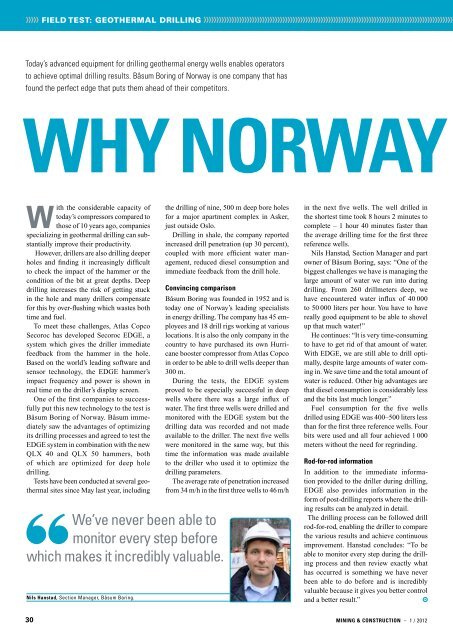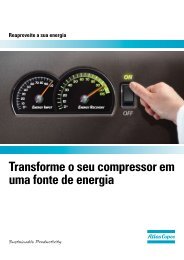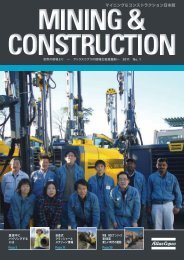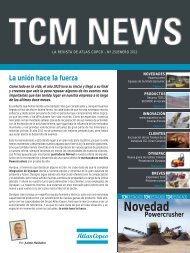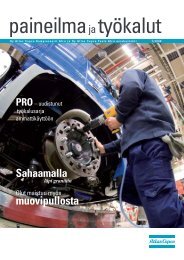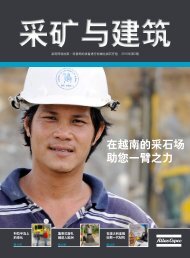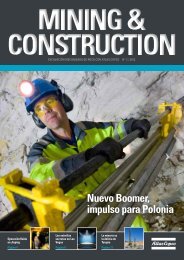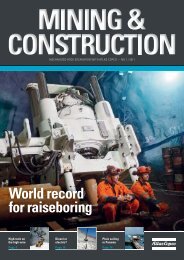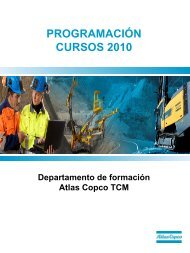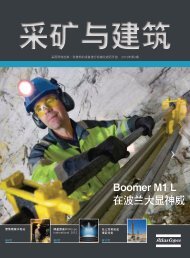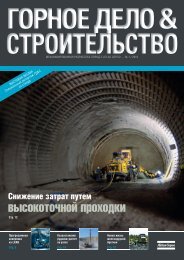Exploration drilling Serbian style - Atlas Copco
Exploration drilling Serbian style - Atlas Copco
Exploration drilling Serbian style - Atlas Copco
You also want an ePaper? Increase the reach of your titles
YUMPU automatically turns print PDFs into web optimized ePapers that Google loves.
FIELD TEST: GEOTHERMAL DRILLING >>>>>>>>>>>>>>>>>>>>>>>>>>>>>>>>>>>>>>>>>>>>>>>>>>>>>>>>>>>>>>>>>>>>>>>>>>>>>>>>>>>>>>>>>>>>>>>>>>><br />
Today’s advanced equipment for <strong>drilling</strong> geothermal energy wells enables operators<br />
to achieve optimal <strong>drilling</strong> results. Båsum Boring of Norway is one company that has<br />
found the perfect edge that puts them ahead of their competitors.<br />
Why Norway<br />
With the considerable capacity of<br />
today’s compressors compared to<br />
those of 10 years ago, companies<br />
specializing in geothermal <strong>drilling</strong> can substantially<br />
improve their productivity.<br />
However, drillers are also <strong>drilling</strong> deeper<br />
holes and finding it increasingly difficult<br />
to check the impact of the hammer or the<br />
condition of the bit at great depths. Deep<br />
<strong>drilling</strong> increases the risk of getting stuck<br />
in the hole and many drillers compensate<br />
for this by over-flushing which wastes both<br />
time and fuel.<br />
To meet these challenges, <strong>Atlas</strong> <strong>Copco</strong><br />
Secoroc has developed Secoroc EDGE, a<br />
system which gives the driller immediate<br />
feedback from the hammer in the hole.<br />
Based on the world’s leading software and<br />
sensor technology, the EDGE hammer’s<br />
impact frequency and power is shown in<br />
real time on the driller’s display screen.<br />
One of the first companies to successfully<br />
put this new technology to the test is<br />
Båsum Boring of Norway. Båsum immediately<br />
saw the advantages of optimizing<br />
its <strong>drilling</strong> processes and agreed to test the<br />
EDGE system in combination with the new<br />
QLX 40 and QLX 50 hammers, both<br />
of which are optimized for deep hole<br />
<strong>drilling</strong>.<br />
Tests have been conducted at several geothermal<br />
sites since May last year, including<br />
We’ve never been able to<br />
monitor every step before<br />
which makes it incredibly valuable.<br />
Nils Hanstad, Section Manager, Båsum Boring.<br />
the <strong>drilling</strong> of nine, 500 m deep bore holes<br />
for a major apartment complex in Asker,<br />
just outside Oslo.<br />
Drilling in shale, the company reported<br />
increased drill penetration (up 30 percent),<br />
coupled with more efficient water management,<br />
reduced diesel consumption and<br />
immediate feedback from the drill hole.<br />
Convincing comparison<br />
Båsum Boring was founded in 1952 and is<br />
today one of Norway’s leading specialists<br />
in energy <strong>drilling</strong>. The company has 45 employees<br />
and 18 drill rigs working at various<br />
locations. It is also the only company in the<br />
country to have purchased its own Hurricane<br />
booster compressor from <strong>Atlas</strong> <strong>Copco</strong><br />
in order to be able to drill wells deeper than<br />
300 m.<br />
During the tests, the EDGE system<br />
proved to be especially successful in deep<br />
wells where there was a large influx of<br />
water. The first three wells were drilled and<br />
monitored with the EDGE system but the<br />
<strong>drilling</strong> data was recorded and not made<br />
available to the driller. The next five wells<br />
were monitored in the same way, but this<br />
time the information was made available<br />
to the driller who used it to optimize the<br />
<strong>drilling</strong> parameters.<br />
The average rate of penetration increased<br />
from 34 m/h in the first three wells to 46 m/h<br />
in the next five wells. The well drilled in<br />
the shortest time took 8 hours 2 minutes to<br />
complete – 1 hour 40 minutes faster than<br />
the average <strong>drilling</strong> time for the first three<br />
reference wells.<br />
Nils Hanstad, Section Manager and part<br />
owner of Båsum Boring, says: “One of the<br />
biggest challenges we have is managing the<br />
large amount of water we run into during<br />
<strong>drilling</strong>. From 260 drillmeters deep, we<br />
have encountered water influx of 40 000<br />
to 50 000 liters per hour. You have to have<br />
really good equipment to be able to shovel<br />
up that much water!”<br />
He continues: “It is very time-consuming<br />
to have to get rid of that amount of water.<br />
With EDGE, we are still able to drill optimally,<br />
despite large amounts of water coming<br />
in. We save time and the total amount of<br />
water is reduced. Other big advantages are<br />
that diesel consumption is considerably less<br />
and the bits last much longer.”<br />
Fuel consumption for the five wells<br />
drilled using EDGE was 400–500 liters less<br />
than for the first three reference wells. Four<br />
bits were used and all four achieved 1 000<br />
meters without the need for regrinding.<br />
Rod-for-rod information<br />
In addition to the immediate information<br />
provided to the driller during <strong>drilling</strong>,<br />
EDGE also provides information in the<br />
form of post-<strong>drilling</strong> reports where the <strong>drilling</strong><br />
results can be analyzed in detail.<br />
The <strong>drilling</strong> process can be followed drill<br />
rod-for-rod, enabling the driller to compare<br />
the various results and achieve continuous<br />
improvement. Hanstad concludes: “To be<br />
able to monitor every step during the <strong>drilling</strong><br />
process and then review exactly what<br />
has occurred is something we have never<br />
been able to do before and is incredibly<br />
valuable because it gives you better control<br />
and a better result.”<br />
30 Mining & Construction – 1 / 2012


